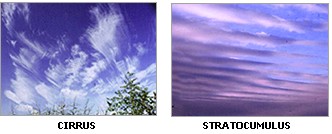DK Science: Clouds
Air always contains some water vapour from oceans, lakes, and the ground. Clouds form when the air cools below a certain temperature, so that some of the water vapour turns to liquid water or ice. Clouds are made up of millions of minute water droplets or ice crystals, which are so tiny that they float in air. The amount of water vapour that air contains is called its HUMIDITY. Warm, humid air often sets off THUNDERSTORMS.

Clouds are named according to their shape and height above sea level. Cumuliform clouds are heaped and stratiform clouds are layered; and “alto-” means medium-level and “cirro-” high-level. So cumulus clouds are low-level and heaped; stratus clouds are low and layered; and altocumulus are medium-level, heaped clouds. Cirris clouds are high and wispy.
For clouds to form, humid air must rise. It expands and cools as it rises, making its water vapour turn to liquid water or ice. Air rises in three different ways:
On warm days, the ground heats the air above it. The air expands and floats upwards, forming convection clouds.
When air reaches a mountain range, it is forced to rise and cool. This forms clouds called orographic clouds.
At a weather front (where warm and cool air meet), the warm air rises over the cold air, forming frontal clouds.
Humidity is the amount of water vapour in the air. The warmer the air is, the more water vapour it can contain. Saturated air is air that contains the maximum amount of water vapour for a particular temperature. Relative humidity is the actual amount of water vapour in the air, compared to the amount needed for the air to be saturated. Saturated air has a relative humidity of 100 per cent.
Mist is a layer of cloud that lies close to the ground. It forms when warm, humid air comes into contact with an area of cold water or cold ground. This can happen when humid air touches ground that has cooled quickly on still, cloudless nights. Fog develops in the same way, but is thicker than mist.
If the air temperature falls below freezing (0°C or 32°F), hoarfrost may form. Surfaces on the ground become covered by ice crystals, which look like a light dusting of snow. Dew forms when some of the water vapour in humid air comes into contact with cold surfaces at ground level. The vapour then turns into tiny drops of liquid water instead of frost.
A thunderstorm begins when a cumulonimbus cloud grows extremely large. The cloud produces lightning, thunder, heavy rain or hail, strong winds, and even tornadoes. About 40,000 thunderstorms happen in the world every day – mostly in the tropics, where the air is very warm and humid. A thundercloud can be recognized by its broad, flattened top.
A flash of lightning is a giant spark of electricity. When ice crystals and water droplets move about and collide inside a thundercloud, static electricity builds up. Lightning is set off when the spark jumps through a cloud, or from one cloud to another, or from a cloud to the ground. A bolt of lightning heats the air to about 30,000°C (54,000°F) so the air expands suddenly and causes a clap of thunder.
Negative electric charge builds up in the base of a thundercloud, and positive charge in the top. The negative and positive charges are attracted to each other, so lightning can strike through the cloud. The negative charge in the cloud’s base also attracts positive charges in the ground, so eventually a lightning spark leaps through the air between the cloud and the ground.

